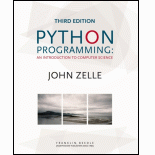
Python Programming: An Introduction to Computer Science
3rd Edition
ISBN: 9781590282779
Author: John Zelle
Publisher: Franklin Beedle & Associates
expand_more
expand_more
format_list_bulleted
Question
Chapter 8, Problem 10PE
Program Plan Intro
Fuel efficiency of a multi-leg journey
Program Plan:
- Declare the “MPG” function.
- Assign the values to the variables.
- Iterate the “for” loop until it reaches the last line in the text file.
- Set the value.
- Check “leg” is not equal to newline.
- In “try” block,
- Split the odometer reading and amount of gas from the user input and assign it into the separate variables.
- Increment the “count” value.
- Calculate the distance traveled, total distance.
- Calculate the MPG for leg.
- Set the new odometer reading.
- Display the leg.
- Add values to trip total.
- Break the function.
- In exception block, break the function.
- Return the value to the main function.
- In “try” block,
- Declare a main function. Inside the main function,
- Get the input file name from the user.
- Open the file.
- Get the starting odometer reading from the user.
- Call the function “MPG”.
- Calculate the total MPG.
- Display the result.
- Call the main function.
Expert Solution & Answer
Want to see the full answer?
Check out a sample textbook solution
Students have asked these similar questions
I want to solve 13.2 using matlab please help
a) Show a possible trace of the OSPF algorithm for computing the routing table in Router 2 forthis network.b) Show the messages used by RIP to compute routing tables.
using r language to answer question 4 Question 4: Obtain a 95% standard normal bootstrap confidence interval, a 95% basic bootstrap confidence interval, and a percentile confidence interval for the ρb12 in Question 3.
Chapter 8 Solutions
Python Programming: An Introduction to Computer Science
Ch. 8 - Prob. 1TFCh. 8 - Prob. 2TFCh. 8 - Prob. 3TFCh. 8 - Prob. 4TFCh. 8 - Prob. 5TFCh. 8 - Prob. 6TFCh. 8 - Prob. 7TFCh. 8 - Prob. 8TFCh. 8 - Prob. 9TFCh. 8 - Prob. 10TF
Ch. 8 - Prob. 1MCCh. 8 - Prob. 2MCCh. 8 - Prob. 3MCCh. 8 - Prob. 4MCCh. 8 - Prob. 5MCCh. 8 - Prob. 6MCCh. 8 - Prob. 7MCCh. 8 - Prob. 8MCCh. 8 - Prob. 9MCCh. 8 - Prob. 10MCCh. 8 - Prob. 2DCh. 8 - Prob. 3DCh. 8 - Prob. 1PECh. 8 - Prob. 2PECh. 8 - Prob. 3PECh. 8 - Prob. 4PECh. 8 - Prob. 5PECh. 8 - Prob. 6PECh. 8 - Prob. 7PECh. 8 - Prob. 8PECh. 8 - Prob. 9PECh. 8 - Prob. 10PECh. 8 - Prob. 11PECh. 8 - Prob. 12PECh. 8 - Prob. 13PE
Knowledge Booster
Learn more about
Need a deep-dive on the concept behind this application? Look no further. Learn more about this topic, computer-science and related others by exploring similar questions and additional content below.Similar questions
- using r language Obtain a bootstrap t confidence interval estimate for the correlation statistic in Example 8.2 (law data in bootstrap).arrow_forwardusing r language Compute a jackknife estimate of the bias and the standard error of the correlation statistic in Example 8.2.arrow_forwardusing r languagearrow_forward
- using r languagearrow_forwardThe assignment here is to write an app using a database named CIT321 with a collection named students; we will provide a CSV file of the data. You need to use Vue.js to display 2 pages. You should know that this assignment is similar, all too similar in fact, to the cars4sale2 example in the lecture notes for Vue.js 2. You should study that program first. If you figure out cars4sale2, then program 6 will be extremely straightforward. It is not my intent do drop a ton of new material here in the last few days of class. The database contains 51 documents. The first rows of the CSV file look like this: sid last_name 1 Astaire first_name Humphrey CIT major hrs_attempted gpa_points 10 34 2 Bacall Katharine EET 40 128 3 Bergman Bette EET 42 97 4 Bogart Cary CIT 11 33 5 Brando James WEB 59 183 6 Cagney Marlon CIT 13 40 GPA is calculated as gpa_points divided by hrs_attempted. GPA points would have been arrived at by adding 4 points for each credit hour of A, 3 points for each credit hour of…arrow_forwardI need help to solve the following case, thank youarrow_forward
arrow_back_ios
SEE MORE QUESTIONS
arrow_forward_ios
Recommended textbooks for you
 EBK JAVA PROGRAMMINGComputer ScienceISBN:9781337671385Author:FARRELLPublisher:CENGAGE LEARNING - CONSIGNMENT
EBK JAVA PROGRAMMINGComputer ScienceISBN:9781337671385Author:FARRELLPublisher:CENGAGE LEARNING - CONSIGNMENT C++ Programming: From Problem Analysis to Program...Computer ScienceISBN:9781337102087Author:D. S. MalikPublisher:Cengage LearningProgramming Logic & Design ComprehensiveComputer ScienceISBN:9781337669405Author:FARRELLPublisher:Cengage
C++ Programming: From Problem Analysis to Program...Computer ScienceISBN:9781337102087Author:D. S. MalikPublisher:Cengage LearningProgramming Logic & Design ComprehensiveComputer ScienceISBN:9781337669405Author:FARRELLPublisher:Cengage C++ for Engineers and ScientistsComputer ScienceISBN:9781133187844Author:Bronson, Gary J.Publisher:Course Technology Ptr
C++ for Engineers and ScientistsComputer ScienceISBN:9781133187844Author:Bronson, Gary J.Publisher:Course Technology Ptr Microsoft Visual C#Computer ScienceISBN:9781337102100Author:Joyce, Farrell.Publisher:Cengage Learning,COMPREHENSIVE MICROSOFT OFFICE 365 EXCEComputer ScienceISBN:9780357392676Author:FREUND, StevenPublisher:CENGAGE L
Microsoft Visual C#Computer ScienceISBN:9781337102100Author:Joyce, Farrell.Publisher:Cengage Learning,COMPREHENSIVE MICROSOFT OFFICE 365 EXCEComputer ScienceISBN:9780357392676Author:FREUND, StevenPublisher:CENGAGE L

EBK JAVA PROGRAMMING
Computer Science
ISBN:9781337671385
Author:FARRELL
Publisher:CENGAGE LEARNING - CONSIGNMENT

C++ Programming: From Problem Analysis to Program...
Computer Science
ISBN:9781337102087
Author:D. S. Malik
Publisher:Cengage Learning

Programming Logic & Design Comprehensive
Computer Science
ISBN:9781337669405
Author:FARRELL
Publisher:Cengage

C++ for Engineers and Scientists
Computer Science
ISBN:9781133187844
Author:Bronson, Gary J.
Publisher:Course Technology Ptr

Microsoft Visual C#
Computer Science
ISBN:9781337102100
Author:Joyce, Farrell.
Publisher:Cengage Learning,

COMPREHENSIVE MICROSOFT OFFICE 365 EXCE
Computer Science
ISBN:9780357392676
Author:FREUND, Steven
Publisher:CENGAGE L
C - File I/O; Author: Tutorials Point (India) Ltd.;https://www.youtube.com/watch?v=cEfuwpbGi1k;License: Standard YouTube License, CC-BY
file handling functions in c | fprintf, fscanf, fread, fwrite |; Author: Education 4u;https://www.youtube.com/watch?v=aqeXS1bJihA;License: Standard Youtube License